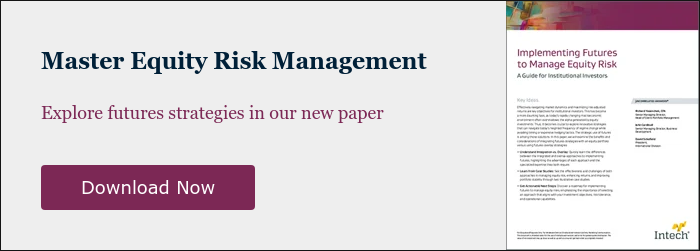Investors are often faced with a paradox: the need for diversification and the desire for precision. On the one hand, we want to spread our risks across a broad range of assets and sectors. On the other hand, we want to target our investments to capture specific opportunities and manage specific risks. This paradox becomes particularly pronounced in times of frequent regime changes, where the dynamics of the market can shift rapidly and unpredictably.
In such times, one approach that can help navigate this paradox is the use of overlay strategies. Overlay strategies represent an alternative approach to managing equity risk, applying futures contracts to the entire equity mandate and providing a broader risk management framework for portfolios.
One of the primary benefits of overlay strategies is their ability to manage portfolio-wide risks effectively. By utilizing futures contracts to hedge against adverse market movements, overlay strategies serve as a robust risk management tool, akin to an insurance policy providing downside protection and mitigating the impact of market downturns on the entire portfolio.
Consider a scenario where a sudden shift in monetary policy leads to a surge in interest rates. This could trigger a sell-off in the equity markets, causing substantial losses for equity-heavy portfolios. An overlay strategy could help mitigate this risk. By holding futures contracts that are expected to increase in value during such a scenario, the losses on the equity side could be offset, protecting the portfolio’s overall value.
In addition to risk management, overlay strategies provide an effective tool for managing liquidity needs within your portfolio. The inherent leverage and ease of trading offered by futures contracts enable prompt management of cash flow requirements, providing valuable flexibility in navigating changing market conditions.
For instance, in a regime where liquidity is tight, an overlay strategy could use futures contracts to gain exposure to certain assets or sectors without having to invest additional capital. This would allow the portfolio to maintain its target asset allocations and capture potential returns, without disrupting its liquidity profile.
Overlay strategies also offer a flexible solution for efficient portfolio rebalancing. Rather than engaging in costly and time-consuming transactions involving physical securities, overlay strategies enable swift adjustment of portfolio exposures through futures contracts. This flexibility enhances the efficiency of the portfolio management process by reducing transaction costs and minimizing market impact.
Imagine a regime where certain sectors are outperforming others. An overlay strategy could adjust the portfolio’s exposures to these sectors by taking long positions in futures contracts linked to these sectors. This would allow the portfolio to capture the potential upside of these sectors, without having to buy or sell the underlying securities.
Like integrated strategies, an overlay approach may invite general risks like the speculative nature of futures and specific risks such as potential overexposure to equity markets. However, overlay strategies also present their own set of considerations and challenges. The application of futures contracts introduces an additional layer of complexity to your investment strategy. It requires specialized expertise to execute overlay strategies effectively and align them with your overall investment objectives. The mismanagement or misalignment of overlay strategies can lead to unintended risks and suboptimal performance.
Additionally, overlay strategies have the potential for higher costs. Unlike integrated strategies, where futures management and equity mandates are combined under one entity, futures overlay strategies may come with higher fees given the scope and complexities of their mandate. Furthermore, the overlay strategies potentially necessitate extra due diligence. Investors must be prepared to dedicate time and resources to continuously monitor and adjust the strategy, ensuring it remains aligned with changing market conditions and investment objectives. This additional layer of complexity requires a commitment to ongoing oversight and management, which can also contribute to higher operational and governance costs.
In conclusion, overlay strategies offer a powerful approach to managing equity risk and optimizing portfolio efficiency. They provide comprehensive risk management, efficient rebalancing, and agile liquidity management capabilities. However, they also require specialized expertise and ongoing monitoring to ensure alignment with investment objectives and adaptability to changing market dynamics.
In our next post, we’ll delve into the comparison between integrated futures strategies and overlay strategies, providing a comprehensive analysis to guide investors in today’s new market order. Stay tuned!



